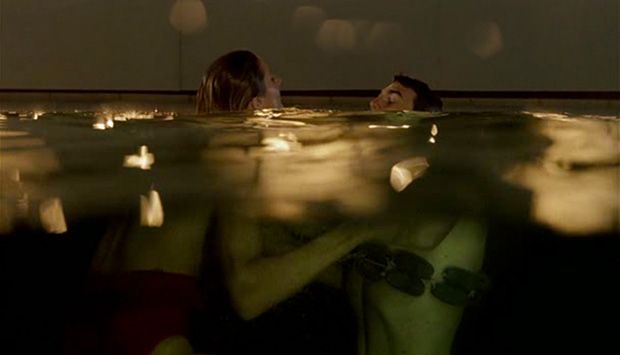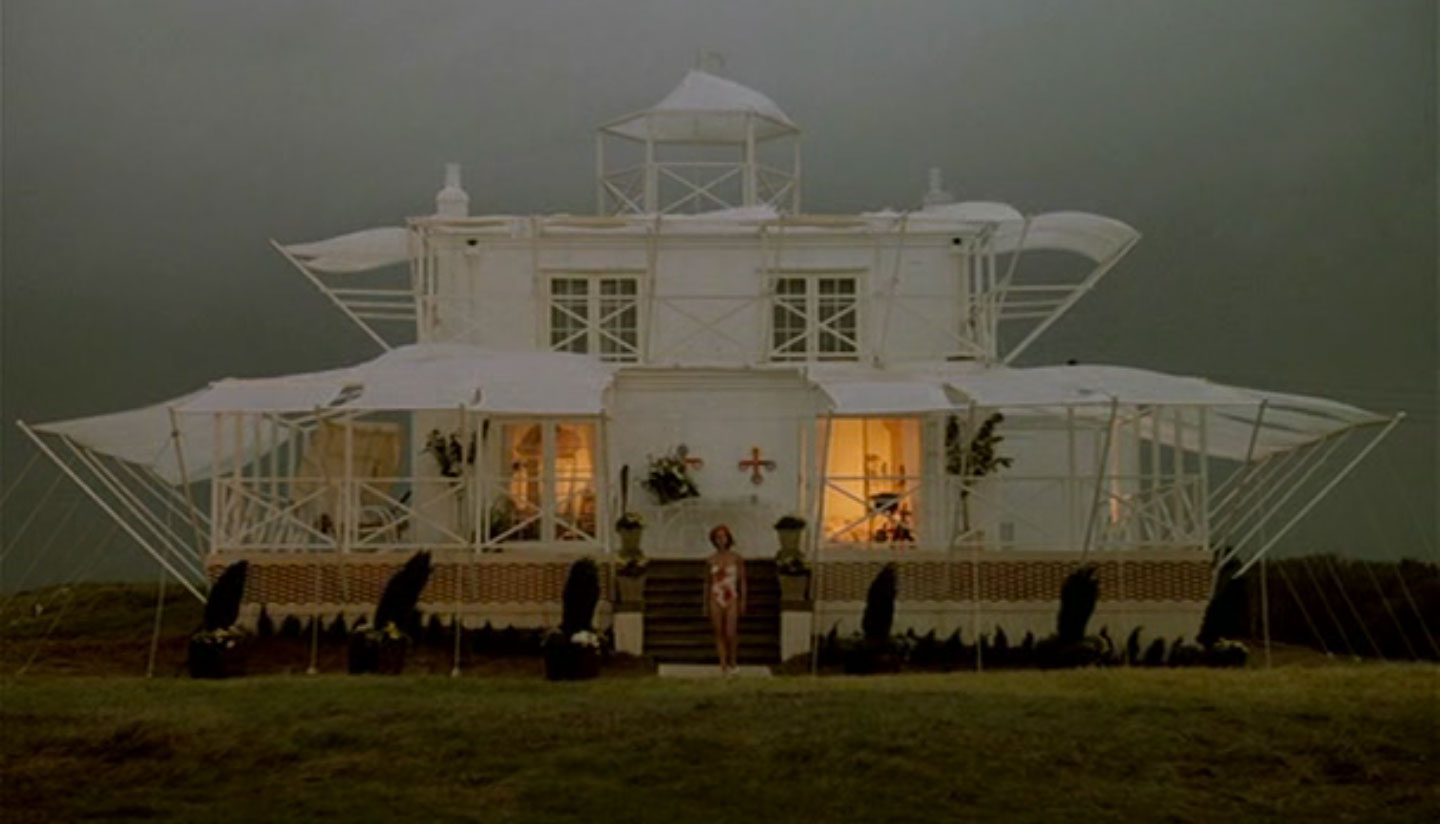Cissie #1: Who’s going to play this game?
Madgett: The good and the evil.
Cissie #2: Who’s good and who’s evil?
Madgett: It depends on how you look at it.
The film critic Manny Farber once said there are two types of films, “termites and white elephants.” Termite films “feels its way through the walls of particularization, with no sign that the artists has any object in mind other than eating away at the immediate boundaries of his art and turning these boundaries into conditions of his next achievement.”
In other words, termite art refuses to bow to formal dictates, while white elephant art is the stuff of prestige films. Termite artists Farber describes as “ornery, wasteful, stubbornly self-involved, doing go-for-broke art, and not caring what comes of it.” This brings us to Peter Greenaway and his 1988 termite film Drowning by Numbers.
Greenaway is a man depressed by the modern state of film, not merely because of the explosion of IP franchise cinema, but because he’s baffled why so few filmmakers take advantage of what is crucially a visual medium. Look at any of his films, Drowning by Numbers included, and you’ll see a man besotted with images and color in a way that, much like Wong Kar-wai, makes you feel as if we’ve been making movies wrong all these years.

Greenaway, a painter by trade, feels his mission as a filmmaker is to ensure the audience always remembers we are watching a film. To Greenaway, big-budget escapism, blockbuster melodramas, or indie slice-of-life observations are nothing but illustrated text. The image is king for him, and every other aspect of filmmaking should serve his highness.
Drowning by Numbers refuses to coalesce into anything resembling a narrative, as much as a steady flow of events in chronological order. Greenaway turns Drowning by Numbers into a game, with the number one appearing in the beginning; as we slowly count to a hundred, the numbers appear either on screen, in the music, or the dialogue. Why a hundred? As we’re informed by the little girl skipping rope and counting stars, played by Natalie Morse, “Once you’ve counted 100, all the other hundreds are the same.”
Greenaway arranges a series of eerie fairy-tale-style stories about three generations of women named Cissie Colpitts, played by Joan Plowright, Juliet Stevenson, and Joley Richardson. The three women form a bond by drowning their husbands. Each husband is less and less deserving of their fate as the numbers count down, and we wonder if the ladies will stop after husband number three.
Greenaway, who also wrote the script, delights in building and repeating. One husband down, one funeral held, and a grieving suspicious relative arriving in town. The execution of counting down is brilliantly executed, but I couldn’t help but be more affected by how Greeanway builds tension in other ways.
After each drowning, more people become suspicious. As the Colpitts drive by the water tower, they see a growing group of people: friends, cousins, and even people they are having an affair with. Each new murder brings more people and suspicion upon the ladies. The numbers onscreen are the ticking clock, whereas the images of the growing mob are the walls closing in.
Luckily, the murderous trio wrangles the local coroner Madgett (Bernard Hill) and his son Smut (Jason Edwards) into helping them cover up the murders. Poor Madgett, hopelessly besotted by the older Cissie, agrees to cover up the first murder if she’ll marry him. She reluctantly agrees but has no plans to follow through with it. Of course, if one Cissie can get away with murder and bat their eyes at the coroner, why can’t the other two?
Greenaway boldly plays with us. The numbers sprinkled throughout the movie are like a metronome, keeping time and letting us know how far along we are and how much time there is to go. But also in the way the story repeats itself in sets of three: Three Cissies, three murders, three attempts by Madgett to blackmail and seduce, three funerals, and so forth. Yet, Greenaway isn’t satisfied with merely playing games with us; he has his characters invent and play games.
Throughout Drowning by Numbers, Madgett and Smut are constantly devising and revising complicated games, dragging the Cissies and the other locals into their creations that make Calvinball seem quaint. Games such as Sheep and Tides, Deadman’s Catch, and Hangman’s Cricket have Smut dutifully recording and telling us the rules as Greenaway plunges us into his tale of murderous and sexually fraught woe.

Shot by the legendary Sacha Vierny, one of the most influential European cinematographers, Drowning by Numbers epitomizes the phrase, “every frame a painting.” Greenaway and Vierny craft an almost theatrical artificiality in the compositions. I say almost because while there is a sense of theatricality to Ben van Os and Jan Roelfs’s sumptuous set design, Vierny and Greenaway are never bound by anything as restraining as a stage.
Vierny’s camera glides across the frame, sometimes changing direction but always with silky smooth ease, revealing an expansiveness to the setting that refuses to be contained by the screen. Vierny and Greenaway imbue a texture to their imagery. The squashed fruit with bugs crawling over it as the sounds of two people having sex play over the image ferment a feeling of palpable, almost squelching sensations.
At the same time, Vierny’s camera captures the naked form of both men and women with an honest, almost cynical eye. Bodies are shapes and sizes to be arranged, yet far from being sterile, Greenaway finds moments of daring eroticism. Greenaway and Vierny stage the actors like paintings, evocative and luscious. Stevenosn’s Cissie is pleasured by her husband Hardy (Trevor Cooper) with a popsicle. Greenaway and Vierny capture the scene with a palpable sense of carnality.
The artificiality and gamesmanship of Drowning by Numbers allow for what would be taboo in another filmmaker’s hands to be more digestible. Greenaway’s dialogue is dry and crisp as his characters exude an almost manically British attitude. One such moment has the three Cissies in a parked car shortly after the first drowning.
The three discuss the deceased husband and the woman he was having an affair with. When asked how old she was, the younger one replied, “Older than me and with bigger tits.” When asked what she means, she says, “It means Jake made a play for me, once.”
Unlike many directors who use artificiality, Greenaway allows his actors to craft a performance as rich and layered as his imagery. The look on Plowright’s Cissie’s face is an entire monologue as her other daughter confesses a similar instance.
It’s a harmonic symphony of words and emotions without Greenaway ever rescinding more than a few moments to them. Always wary of becoming text-based imagery, he chooses his words wisely and allows the turbulent tide of emotions underneath Plowright’s face to provide all the proof we need of the desperate squall underneath.
The actors in Drowning by Numbers have an arduous task. Greenaway doesn’t provide much in the way of exposition or monologues, and without a narrative, it must be hard to craft any map for the character. Yet, they manage to say so much with so little, alluding to a valley of emotions without ever putting words to them. Greenaway conducts them beautifully, leading them to emotional pitches, while Vierny uses the lighting and set to aid in their performance.
One of the most remarkable things about Drowning By Numbers is how, without running around and chasing the truth, it often stumbles on ecstatic truths. Truths like how people misconstrue perfectly innocent photos Madgett has taken of Smut. Or the gentle way Stevenson’s Cisse cuts her dead husband’s hair because it used to calm him down. The truths Greenaway discovers in Drowning by Numbers are humanistic. Complex and mundane, despite the macabre cynicism, are strangely moving.
It’s easy to say that echoes of Greenaway’s style are evident in the works of Wes Anderson. But that would be a misunderstanding of where and how their styles get their inspiration. Greenaway’s frames are paintings, evocative and stirring, whereas Anderson’s visuals are informed by text. Indeed, Greenaway deems much of cinema as “images with the text,” an apt description for Anderson as he might well be the most literate of any mainstream director working today outside of Scorsese.

For Anderson, his films have hemmed-in quality. His imagery is inspired by words. Anderson’s staging and composition seem to come from the same place as a writer, staging scenes much in the same way a writer crafts a sentence, often for the sheer soundsex of it.
Greenaway’s imagery, however, is richer and attempts to overwhelm. But most importantly, the main reason the comparison falls apart is that Anderson is wedded to, obsessively, a narrative, an act that Greenaway finds repulsive to his very core.
At every step, Greenaway draws your attention to the artificiality, whether it’s through John Wilson’s editing, which, combined with Vierny’s lens, creates a feeling of continuous movement while also casting a haunting spell of fairy-tale wonder on us. Surreal is an understatement as Greenaway uses Wilson’s cutting to draw us into a somnambulistic atmosphere, with occasional nightmarish undertones. I remember one vivid moment where Plowright’s Cissie appears out of thin air in a darkened room after a lightning strike.
Pulsating and throbbing throughout Drowning by Numbers is Michael Nyman’s expressive score. Like Greenaway’s use of patterns, games, and numbering, Nyman’s music is both new and old, using bits and pieces of Mozart’s “Sinfonia Concertante in E Flat,” showing us how the past influences the future, even when we are unaware of its influence.
Some may roll their eyes and call Drowning by Numbers pretentious. Prentious is a word increasingly used by plotcels to attack filmmakers who have the temerity to take the art of film seriously.
I’ve seen many a well-plotted film that didn’t hold half as many delights and surprises as Drowning by Numbers, a film filled with rage, tenderness, sentimentality, lewdness, moralism, and visual trickery. It’s easy to dismiss Greenaway’s film as a hollow masterpiece, but that’s only if you think being transported, delighted, engaged and challenged is a minor achievement. I don’t.
Images courtesy of Prestige
Have strong thoughts about this piece you need to share? Or maybe there’s something else on your mind you’re wanting to talk about with fellow Fandomentals? Head on over to our Community server to join in the conversation!

